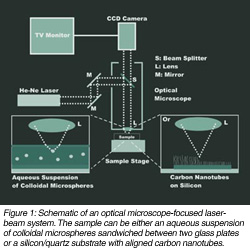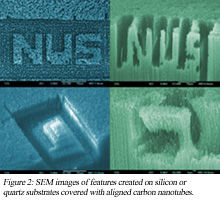|
by Dr Sow Chorng Haur
 he term "optical tweezers" refers to the technique first developed by Dr Art Ashkin in 1986 wherein a tightly focused laser beam is used to attract and trap tiny particles whose refractive index exceeds that of the surrounding medium. Optical tweezers have found particular use in the manipulation of very small objects like microspheres made of polystyrene or silica. These devices are useful in the study of microscopic interactions, biophysics, the assembly of microbeads, and the creation of micron-sized structures. he term "optical tweezers" refers to the technique first developed by Dr Art Ashkin in 1986 wherein a tightly focused laser beam is used to attract and trap tiny particles whose refractive index exceeds that of the surrounding medium. Optical tweezers have found particular use in the manipulation of very small objects like microspheres made of polystyrene or silica. These devices are useful in the study of microscopic interactions, biophysics, the assembly of microbeads, and the creation of micron-sized structures.
A group of researchers at the National University of Singapore has developed an optical-tweezers system to carry out a series of different experiments. Figure 1 shows the schematic of the optical tweezers system used by Dr Sow Chorng Haur and his team from the Department of Physics, Faculty of Science. It has a He-Ne laser emitting low-powered (30mW) red light with a wavelength of 632.8nm.

The operator directs the laser beam towards an optical microscope by means of two mirrors. Once inside the microscope, the beam gets directed in turn towards an objective lens via a beam splitter and then focused onto the sample by a high-magnification (150x) objective lens with a high numerical aperture (0.95). The same objective lens collects reflected light from the sample for viewing purposes. Finally the operator uses a charge-coupled device (CCD) camera to collect the images for viewing and recording purposes.
This simple and inexpensive set-up represents a very versatile system that facilitates the study of microscopic interaction and the assembly of microspheric structures. In addition to single-spot tweezers, one can convert a single spot into multiple spots with sufficient laser power. Each of these spots will act as an individual trapping place. The team works closely with Dr Cherry Murray of Bell Labs and the Department of Physics, Kenyon College, in the United States, to conduct these experiments.
In a recent development, Sow's team and the Centre for Integrated Circuit Failure Analysis and Reliability at NUS experimented with the instruments, and to their surprise, they succeeded in using the optical tweezers as a tool for micropruning. When they focused a laser beam from a low-power laser onto a substrate with well-aligned carbon nanotubes (CNTs), the CNTs were burned away and truncated. By scanning the beam across the sample, they were able to generate micropatterns on the CNT-covered surface (Figure 1) - features as small as 500nm (about 1/150 the diameter of a human hair).
 By selectively focusing the beam at different levels and tilting the sample, they also created interesting three-dimensional freestanding structures made of CNTs (Figure 2). By selectively focusing the beam at different levels and tilting the sample, they also created interesting three-dimensional freestanding structures made of CNTs (Figure 2).
The project is unique in its usage of an optical tweezers system on CNTs instead of the conventional purpose of grabbing and manipulating things. Here the scientists use the focused laser beam as a tool for microcutting of nanotubes. They believe that this is the first time the established technique has been employed in CNTs to create very interesting structures.
Work is currently in progress to explore the possibility of using the technique to make interesting devices for field-emission purposes and devices with movable parts made of CNTs, as well as to study the properties of CNTs before and after they are truncated. Sow will also be working with colleagues from the NUS's Division of Bioengineering to use the optical tweezers for the micromanipulation of cells in biophysics.
For more information contact Dr Sow Chorng Haur at physowch@nus.edu.sg.
|


 he term "optical tweezers" refers to the technique first developed by Dr Art Ashkin in 1986 wherein a tightly focused laser beam is used to attract and trap tiny particles whose refractive index exceeds that of the surrounding medium. Optical tweezers have found particular use in the manipulation of very small objects like microspheres made of polystyrene or silica. These devices are useful in the study of microscopic interactions, biophysics, the assembly of microbeads, and the creation of micron-sized structures.
he term "optical tweezers" refers to the technique first developed by Dr Art Ashkin in 1986 wherein a tightly focused laser beam is used to attract and trap tiny particles whose refractive index exceeds that of the surrounding medium. Optical tweezers have found particular use in the manipulation of very small objects like microspheres made of polystyrene or silica. These devices are useful in the study of microscopic interactions, biophysics, the assembly of microbeads, and the creation of micron-sized structures.

 By selectively focusing the beam at different levels and tilting the sample, they also created interesting three-dimensional freestanding structures made of CNTs (Figure 2).
By selectively focusing the beam at different levels and tilting the sample, they also created interesting three-dimensional freestanding structures made of CNTs (Figure 2).